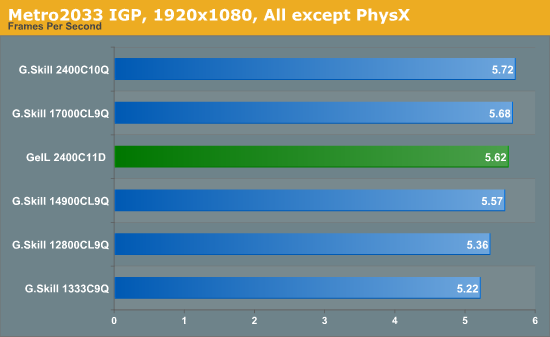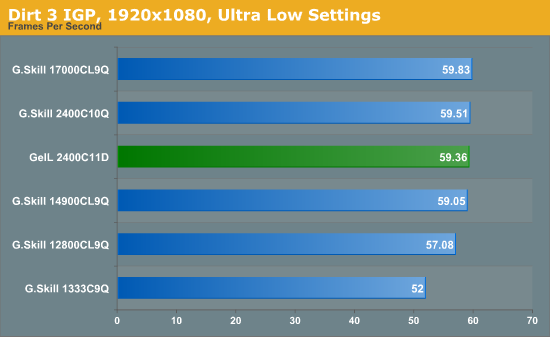GeIL Evo Veloce Review: 2x8GB at DDR3-2400 C11-12-12 1.65 V
by Ian Cutress on October 24, 2012 5:50 PM EST- Posted in
- Memory
- Ivy Bridge
- DDR3
- GeIL
Metro2033
Metro2033 is a DX11 benchmark that challenges every system that tries to run it at any high-end settings. Developed by 4A Games and released in March 2010, we use the inbuilt DirectX 11 Frontline benchmark to test the hardware at 1920x1080 with full graphical settings. Results are given as the average frame rate from 4 runs.

Against DDR3-1333, our GeIL kit today offers a 7.67% increase in frame rates in our Metro2033 test on IGP. This falls in between the 6.86% increase from the 1866 C9 and 8.87% increase from the 2133 C9 kits. Arguably we could conclude that Metro likes lower CL numbers, as the MemTweakIt suggests that our kit should achieve similar to the 2133 C9 kit.
Civilization V
Civilization V is a strategy video game that utilizes a significant number of the latest GPU features and software advances. Using the in-game benchmark, we run Civilization V at 1920x1080 with full graphical settings, similar to Ryan in his GPU testing functionality. Results reported by the benchmark are the total number of frames in sixty seconds, which we normalize to frames per second.

Similar results are seen with Civ V like Metro2033, but this time we get only a 5.29% increase over DDR3-1333. The kit again performs more like a 1866 C9 than the 2133 C9.
Dirt 3
Dirt 3 is a rallying video game and the third in the Dirt series of the Colin McRae Rally series, developed and published by Codemasters. Using the in game benchmark, Dirt 3 is run at 1920x1080 with Ultra Low graphical settings. Results are reported as the average frame rate across four runs.

Even though in the past we have shown Dirt 3 to love CPU MHz and GPU capacity, when it comes to memory the results seem to top off around the 1866 C9 mark. All the kits between 1866 C9 and 2400 C10 give an 8-10% performance boost on IGP over 1333 C9.










30 Comments
View All Comments
mmstick - Saturday, October 27, 2012 - link
Actually, yes you can tell the difference depending on the applications you run. In fact, the distributed OpenCL GPU computing projects I use over at BOINC, the biological research, requires extreme frequencies. The higher the processor frequency, the higher your GPU load and ability to install more GPUs for the project becomes. If I run my RAM at 1333Mhz with my 7950, I need to run 8 work units in order to get that memory to get 80% efficiency. After overclocking my RAM to 1800Mhz I was able to get the efficiency up to 95%. With faster memory, I could run less work units, and install a second graphics cards, although I would likely need 2133Mhz quad channel memory in order to saturate two 7950s in the HCC project. In POEM, I would actually need 4266Mhz quad channel DDR3 in order to saturate a single 7950 more than likely.Another scenario is AMD APUs, where FPS almost scales linearly based on RAM frequency because it uses system RAM as VRAM. GPUs are very memory intense, which is why GPUs have 256-384 bit memory interfaces. With an APU, the GPU on the die is restricted to the lame 64 bit memory interface we have with our system RAM.
RAM kits like these are sold to people who need them, if you don't need them, buy the lower frequency RAM.
mmstick - Saturday, October 27, 2012 - link
"The higher the processor frequency" I meant "The higher the memory frequency"mmstick - Saturday, October 27, 2012 - link
"to get that memory to 80%" should be "to get GPU utilization to 80%"Impulses - Thursday, October 25, 2012 - link
What's with the cost analysis of all these high speed $150 kits? Would you actually shell out that amount of money for a run of the mill gaming/enthusiast system when there's a ton of 1600 4x4GB or even 2x8GB kits on Newegg selling for $75-85?I've wishlisted like half a dozen G.Skill kits within that range AND with blue spreaders specifically... If I width the search there's tons more obviously, just hoping one of those goes on sale during Thanksgiving for like $50-60, even tho I'm in no dire need to upgrade from 8GB.
(and yeah, looking at blue purely for aesthetic reasons obviously!)
mmstick - Saturday, October 27, 2012 - link
I would because it would cut my research rate in half. I run OpenCL GPU projects on my systems, where if I had 2400Mhz memory I could output twice as many work units with my graphics cards per day in Help Conquer Cancer.n0x1ous - Thursday, October 25, 2012 - link
Green PCB? Really? YukBlack or Nothing
bigboxes - Thursday, October 25, 2012 - link
Do you ever look at your ram once you install it?JonnyDough - Friday, October 26, 2012 - link
That's how I feel. I used to care about the color of my computer case, etc but I realized that its more about longevity and ease of installation for me. It's nice to go with a color theme, but the extra cost each time I upgrade just isn't worth it. So now that I've matured a bit I've decided on mostly black boxes and hardware as its plentiful and price competitive.saturn85 - Thursday, October 25, 2012 - link
how about adding a folding on cpu benchmark?valnar - Friday, October 26, 2012 - link
Memory companies will continue to put out insanely spec'ed pieces so they get reviewed by Hardware sites, because it's the only way to get their name out there. Otherwise, memory as a whole is a pretty boring component. Why else do they also need to have interesting names and brightly colored heatsinks? Marketing at its best (or is it worst?)